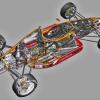Posted 25 November 2005 - 21:09
I saw this chassis when I was in Warsaw/Krakow in the mid/late 90s on holiday. As I did in Prague, so I went to the Technical Museum in Warsaw and saw the chassis here. If you go to those cities I recomend visits to the museums/musea, since they both have super displays of cars, motorbikes, 'planes and trains etc, and all other examples of Eastern bloc engineering, often or invariably underestimated, especially pre war.
A chap called Pawel Pronobis responded to the pics when they were in C&SC and I give you a paraprase of his report, and to him and C&SC I offer my recognition .
The chassis in the museum is the sole surviving chassis of a highly advanced 1930s Plish supercar. It was designed by PZInz, and industrial combine started in 1930 intended to build under licence FIAT and Saurer trucks. but capable in its own right.
The Lux Sport was the brainchild of a patriotic group intent on sowing what Poland could do. Started in 1934 the prototype was ready for tests FIVE months later, so perhaps Vanwall's view of an MGD R type crib is possibly somewhat wide of the mark, especially since it is unlikely that the inner secrets of MG would have filtered through to Polish industrialists, mindful of language and geographical barriers, and a year early. Quite often the same idea, or variations, arise in different places at the same time , plus IIRC Mercedes had a car in the '30s with a tubular backbone chassis, type 170 ?? I may be wrong on that., so probably more of a MB crib if anything, one suspects.
The PZInz featured a compact backbone chassis, in what looked like 1/4 " steel to me, contailning all pipes and lines etc. Suspension Fr and rear was independent, with adjustable ride height, dont ask me how, a quick change diff, (pre Halibrand or a diferent design?) and special ow pressure tyres, probably to accommodate rudimentary road surfaces of the period.
The prototype ran with a FIAT six pot engine but the design team produced its own engine, no mean operation this then, a V8 of 3,888cc, on 6.5:1 compression offering 70kW, 95 horses, at 3,600rpm. Length was given at 3,400mm, width and height 1,460mm, and a weiht of 1,200kg to claim a top speed of 135km/hr.
A Cotal 4 speed electromagnetic gearbox was imported for the second proto. These were displayed at the 1936 Warsaw Industrial Exhibition, clearly no MG agents there. This chassis was discovered post-war in a tractor factory yard and was restored by the Museum staff.
The pictures show the bold six window body style fitted to one chassis onl, with parts for four beig produced, the body designed by S Panczakiewicz, similar to a period Hanomag. Only two were actually built.
Tested in 37 and 38 for over 100,000km the prototype proved very comfortable and well capable of coping wih the period roads.
Sadly the onset of the 1939 hostilities saw the whole thing come to a standstill.
The dampers look as if they could be a Dubonnet variation perhaps.
The suspension is very advanced for the time, I think, and I cannot fathom the inter/cross links fo what look to be torsion bars.
I thought it might be something along the lines of the Nicholls Suspension Stabiliser system which appeared in the early sixties, with diagonally opposed wheels linked via anti-roll bars. IIRC Jeff Uren used them on his 61 saloon championship Zephyr. They were featured in Motor Sport and advertised at around 15 quid.
The chassis really does warrant examination which is why I am obliged to Anders for putting up the photos. Stuff is on the www if you enter PZInz Lux Sport, or auta5p.car.cz and follow the various leads
Looking at the MG R chassis it is obviously built for lightness............... clearly a racer .
Roger Lund.








